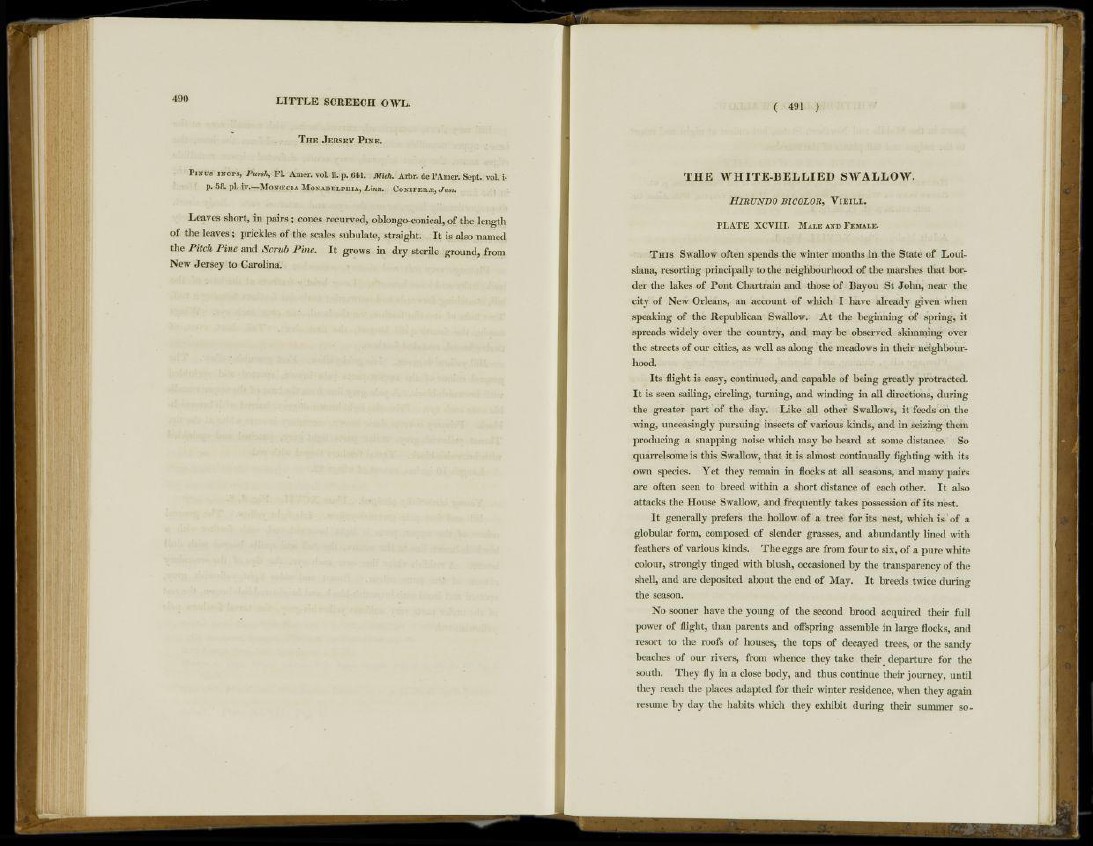
490 L I T T L E SCREECH OWL.
THE JERSEY PINE.
PINUS INOPS, Pursh, F L Amer. v o l . i i . p. 6 4 1 . Mich. Arbr. de l'Amer. Sept. v o l . ip.
5 8 . pi. iv.—MoNUCCIA MoNADELPHIA, Linn. CONIFERS, JUSS.
Leaves short, in pairs ; cones recurved, oblongo-conical, of the length
of the leaves ; prickles of the scales subulate, straight. It is also named
the Pitch Pine and Scrub Pine. It grows in dry sterile ground, from
New Jersey to Carolina.
( 4 9 1 )
T H E W H I T E - B E L L I E D S W A L L O W.
HlRUNDO BICOLOR, VlEILL.
P L A T E X C V I I I . MALE AND FEMALE.
THIS Swallow often spends the winter months in the State of Louisiana,
resorting principally to the neighbourhood of the marshes that border
the lakes of Pont Chartrain and those of Bayou St John, near the
city of New Orleans, an account of which I have already given when
speaking of the Republican Swallow. At the beginning of spring, it
spreads widely over the country, and may be observed skimming over
the streets of our cities, as well as along the meadows in their neighbourhood.
Its flight is easy, continued, and capable of being greatly protracted.
It is seen sailing, circling, turning, and winding in all directions, during
the greater part of the day. Like all other Swallows, it feeds on the
wing, unceasingly pursuing insects of various kinds, and in seizing them
producing a snapping noise which may be heard at some distance. So
quarrelsome is this Swallow, that it is almost continually fighting with its
own species. Yet they remain in flocks at all seasons, and many pairs
are often seen to breed within a short distance of each other. It also
attacks the House Swallow, and frequently takes possession of its nest.
It generally prefers the hollow of a tree for its nest, which is of a
globular form, composed of slender grasses, and abundantly lined with
feathers of various kinds. The eggs are from four to six, of a pure white
colour, strongly tinged with blush, occasioned by the transparency of the
shell, and are deposited about the end of May. It breeds twice during
the season.
No sooner have the young of the second brood acquired their full
power of flight, than parents and offspring assemble in large flocks, and
resort to the roofs of houses, the tops of decayed trees, or the sandy
beaches of our rivers, from whence they take their departure for the
south. They fly in a close body, and thus continue their journey, until
they reach the places adapted for their winter residence, when they again
resume by day the habits which they exhibit during their summer so